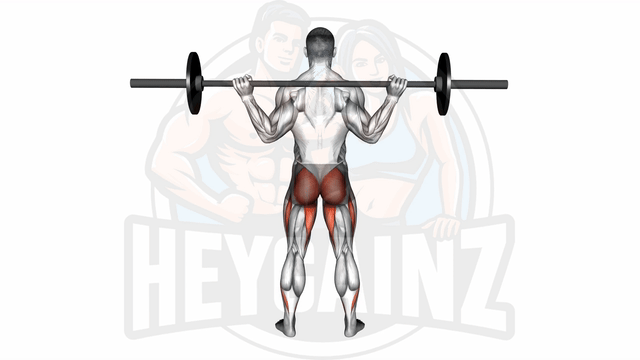
Instructions:
- 1Place the barbell on your upper back just below your neck
- 2Stand with your feet shoulder-width apart
- 3Lower down into a squat position by bending your knees and pushing your hips back
- 4Continue until your thighs are parallel to the floor
- 5Push up to return to the standing position
Tips:
- Keep your back straight throughout the exercise
- Keep your head facing forward, not down
- Prevent your knees from pushing forwards beyond your toes during the squat
- Don't lift heavy weights alone, always have a spotter
Mastering the Barbell Full Squat: A Comprehensive Guide
The barbell full squat is an essential exercise for anyone looking to enhance their lower body strength, primarily targeting the gluteus maximus and quadriceps. This compound movement not only promotes muscle growth but also improves overall stability and mobility. In this article, we'll explore the benefits, alternatives, and important considerations for incorporating barbell squats into your fitness routine.
Benefits of the Barbell Full Squat
Engaging in barbell full squats offers a variety of advantages, including:
- Muscle Development: Helps in building lean muscle mass in the thighs and glutes.
- Enhanced Range of Motion: Improves flexibility and joint health.
- Functional Strength: Increases overall strength that translates into daily activities.
Barbell Deep Squat: An Alternative Approach
Some individuals prefer the barbell deep squat, which focuses on going lower during the squat movement. This variation can increase the intensity and further engage the muscles. Both exercises provide similar benefits, but it's important to choose the one that best fits your goals and comfort level.
How Often Should You Barbell Squat?
For optimal results, it is generally recommended to perform barbell squats 1-3 times per week, depending on your overall fitness plan. This frequency allows adequate recovery while promoting strength progression.
Addressing Safety Concerns
Many people ask, “Is barbell squat dangerous?” Like any exercise, squats carry risks if not performed with proper form. Ensure that you maintain a neutral spine, engage your core, and avoid excessively heavy weights until you have mastered the technique. Consulting with a fitness professional can also help you avoid potential injuries.
Sets and Reps: Finding Your Rhythm
The number of sets and repetitions can vary based on your fitness goals. If you are aiming for strength, consider performing 3-5 sets of 6-8 repetitions. For muscular endurance, 2-4 sets of 10-15 repetitions may be more appropriate. Listen to your body and adjust your regimen accordingly.
Incorporating the barbell full squat into your workout routine can lead to significant strength and muscle gains. As with any exercise, focus on proper form and technique to maximize benefits and minimize risks. Happy squatting!